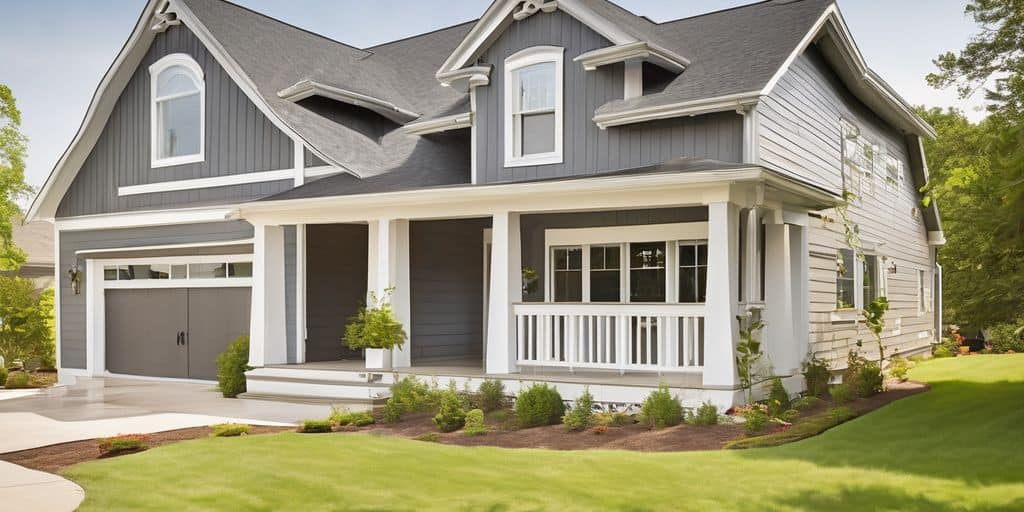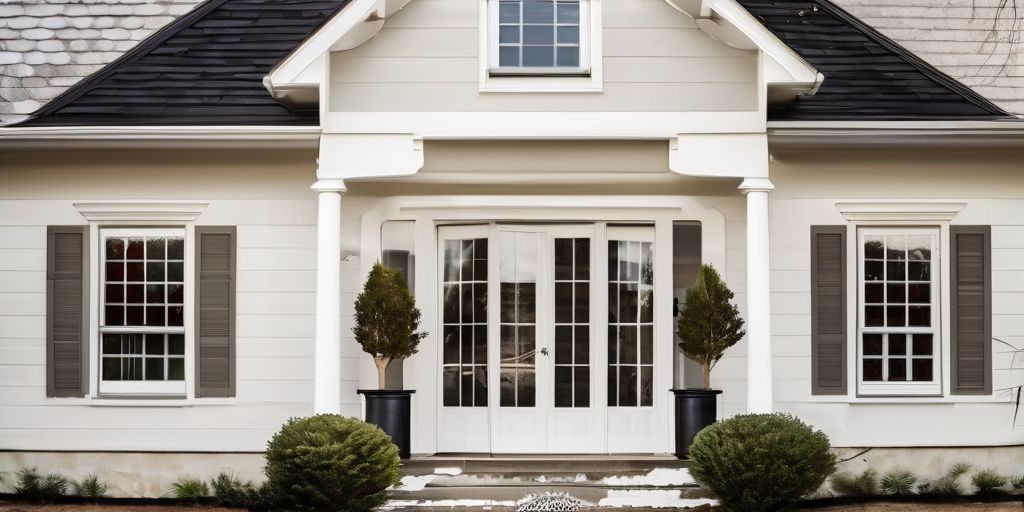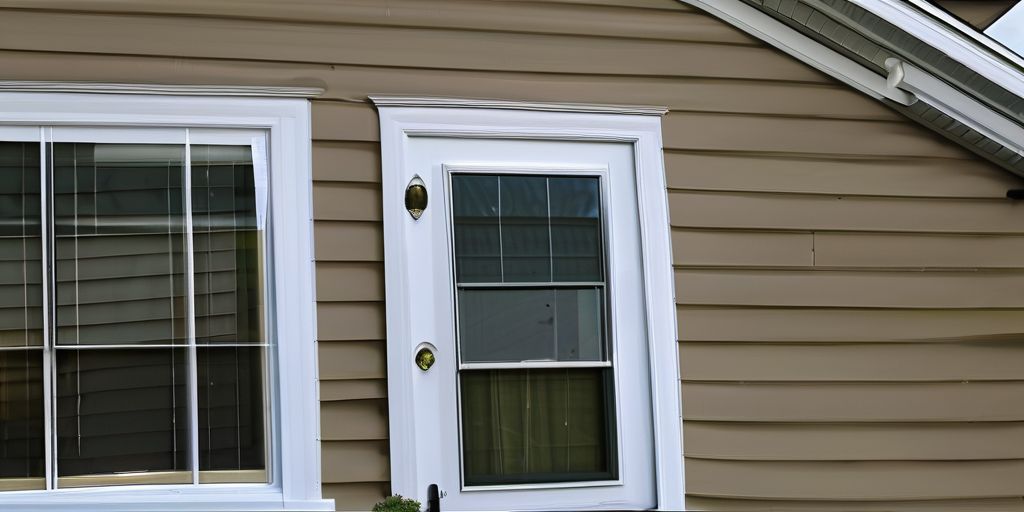The impact of climate on painting vinyl siding is a critical aspect to consider for maintaining both the aesthetic and structural integrity of a home. Understanding how various weather conditions affect paint durability, adhesion, and curing can help homeowners make informed decisions about when and how to paint their vinyl siding to achieve optimal results.
Key Takeaways
- Climate conditions such as extreme temperatures and humidity play a significant role in the durability of paint on vinyl siding.
- Proper surface preparation, including cleaning and priming, is essential for ensuring paint adhesion and longevity.
- Selecting high-quality, UV-resistant paint can significantly enhance the lifespan and appearance of painted vinyl siding.
- Adapting painting schedules to local weather conditions and future weather trends is crucial for optimal paint curing.
- Regular maintenance and timely repairs are necessary to address climate-induced damage and maintain the siding’s condition.
Understanding Climate’s Role in Paint Durability on Vinyl Siding
Factors Influencing Paint Longevity
The durability of paint on vinyl siding is significantly influenced by the local climate. Key factors include extreme temperatures, humidity, and exposure to UV rays, all of which can affect how well the paint adheres and maintains its appearance over time. Here are some key points to consider:
- Climate conditions play a significant role in the longevity of paint on vinyl siding.
- Proper surface preparation is essential for paint adhesion and durability.
- Using high-quality paint can improve the durability and longevity of the finish.
- Priming the surface before painting helps the paint adhere better and last longer.
Adapting Painting Schedules to Weather
It’s important to monitor weather conditions closely and adapt the painting schedule accordingly to avoid rain, extreme heat, or cold snaps. The timing of the paint application can significantly impact the durability and appearance of the final result.
When painting vinyl siding, it’s not just about the day’s forecast but also about the upcoming weather trends that could influence the paint’s curing process.
Future Weather Trends and Paint Curing
When planning a painting project, it’s important to consider the timing. Painting during a period of mild weather can help mitigate the effects of extreme temperatures and humidity on the paint’s drying and curing process. UV exposure, in particular, can fade the color of vinyl siding, making UV-resistant paint a necessity.
The Challenges of Extreme Temperatures on Vinyl Siding
Extreme temperatures pose significant challenges to painting vinyl siding effectively. Understanding how to manage these conditions can greatly enhance the durability and appearance of your home’s exterior.
Effects of Heat and Cold on Paint Adhesion
Extreme heat and cold can severely impact paint adhesion on vinyl siding. During hot weather, the siding can become excessively hot, causing the paint to dry too quickly and hindering proper adhesion. Conversely, cold temperatures slow down the curing process, which can lead to poor adhesion and eventual cracking. To ensure optimal adhesion, avoid painting during periods of extreme temperatures.
Timing Your Paint Application
Choosing the right time to paint is crucial. Aim for mild weather conditions to mitigate the adverse effects of extreme temperatures. This not only helps in achieving better adhesion but also ensures the longevity of the paint job. Timing is everything when it comes to painting vinyl siding.
Preventing Warping and Cracking
To prevent warping and cracking of vinyl siding:
- Ensure the siding is in good condition before painting.
- Choose paints that are suitable for extreme weather conditions.
- Apply paint during stable weather to avoid rapid temperature changes that can affect the siding.
It’s essential to select the right type of paint and apply it under optimal conditions to prevent damage and maintain the aesthetic appeal of your home.
Humidity and Its Impact on Vinyl Siding Paint
Managing Humidity Levels During Painting
Managing humidity is crucial when painting vinyl siding. High humidity can slow down the drying process and affect the adhesion of paint. Here are some tips to manage humidity:
- Paint on days with lower humidity levels.
- Use dehumidifiers if painting indoors or in enclosed spaces.
- Allow extra drying time on humid days.
Proper preparation is essential for painting vinyl siding.
Choosing the Right Time to Paint
Timing is everything when it comes to painting vinyl siding in humid conditions. The best times are usually during the early morning or late afternoon when humidity levels are typically lower. Avoid painting during the peak of humidity which often occurs at midday.
Ensuring Proper Adhesion in Humid Conditions
To ensure that paint adheres properly in humid conditions, consider the following:
- Use paints specifically designed for high humidity.
- Apply a primer designed for vinyl siding to help with paint adhesion.
- Test the paint on a small area first to see how it reacts to the humidity.
It’s essential to choose paint and application techniques that accommodate these challenges to ensure the siding withstands diverse climate conditions.
The Importance of Surface Preparation
Steps for Preparing Vinyl Siding
Proper surface preparation is crucial for the longevity of paint on vinyl siding. Ensuring a clean, dry, and smooth surface can significantly affect the outcome of your painting project. Here are some key steps to prepare your vinyl siding for painting:
- Clean the surface thoroughly to remove any dirt, grime, or mildew.
- Repair any cracks or damages to ensure a smooth application.
- Sand any glossy or rough spots to create a uniform surface for painting.
The Role of Priming
Priming is essential in painting vinyl siding as it helps in achieving a uniform and durable finish. Deciding whether you need a primer largely depends on the condition of your siding and the type of paint you are using. Most paint manufacturers recommend applying a primer, especially if the vinyl is pitted or porous. Here’s why priming is important:
- It helps in covering any underlying colors or stains.
- Enhances the adhesion of paint, reducing the risk of peeling.
- Provides an extra layer of protection against elements.
Choosing UV-resistant Paint
Selecting the right paint is critical when painting vinyl siding, especially considering the exposure to various weather conditions. Opt for UV-resistant paint to ensure the longevity and durability of your paint job. UV-resistant paints help in:
- Preventing fading and discoloration caused by sun exposure.
- Maintaining the vibrancy and gloss of the paint over time.
- Protecting the siding from weather-related damages.
Remember, proper preparation is key to a durable paint job. Taking the time to repair any imperfections can significantly extend the life of your paintwork.
Selecting the Right Paint for Your Climate
Importance of High-Quality Paint
Selecting the right paint for your vinyl siding is crucial. High-quality paint offers enhanced durability and better resistance to weather conditions. Here are some points to consider:
- Choose paints that are specifically formulated for exterior use.
- Opt for paints with low or zero volatile organic compounds (VOCs) to reduce air pollution.
- Seek out products with a longer lifespan to minimize the frequency of repainting.
Adapting Paint Choices to Local Weather
Your local weather plays a significant role in the type of paint you should choose. For instance:
- In areas with high humidity, select paints that prevent moisture penetration.
- For regions experiencing extreme temperatures, choose paints that can withstand thermal expansion and contraction.
Longevity Benefits of Premium Paints
Premium paints not only enhance the appearance of your home but also provide long-term benefits:
- They are more resistant to fading and weathering.
- Premium paints can help save on maintenance costs by reducing the need for frequent touch-ups.
It’s essential to choose a paint that’s formulated to withstand the specific challenges of your climate to ensure the best performance and longevity.
Practical Tips for Painting Vinyl Siding in Various Climates
Planning for Weather Consistency
Consistent weather conditions are crucial for a successful paint job on vinyl siding. Here are some tips to ensure you plan effectively:
- Monitor the upcoming weather forecasts to choose the best possible painting days.
- Aim for dry, mild weather conditions to optimize paint adhesion and curing.
- Avoid painting during unpredictable weather seasons to minimize disruptions.
Avoiding Adverse Weather Conditions
To ensure the longevity and appearance of your paint, it’s essential to avoid adverse weather conditions:
- Do not paint in extreme heat or cold as these can affect paint adhesion.
- Stay clear of rainy or very humid days to prevent paint from washing away or not setting properly.
- Schedule your painting project during a period of stable weather to avoid these issues.
Utilizing Weather Forecasts for Better Results
Utilizing detailed weather forecasts can significantly enhance the outcome of your painting project. Here’s how:
- Check extended weather forecasts to plan your painting schedule around the most favorable conditions.
- Be flexible with your painting dates to accommodate sudden changes in the weather.
- Use weather apps or websites to get real-time updates and make informed decisions on the go.
By adhering to these practical tips and considering the climate, you can achieve a durable and visually appealing finish on your vinyl siding.
Maintaining Your Painted Vinyl Siding Through Seasons
Maintaining the aesthetic appeal and longevity of your painted vinyl siding requires regular care and attention throughout the changing seasons. Here’s how you can keep your siding in top condition year-round:
Routine Checks and Maintenance
- Conduct regular inspections to spot any potential issues early.
- Clean the siding gently with a solution of water and mild soap to prevent buildup of dirt and grime.
- Repair any damages promptly to prevent further deterioration.
Addressing Climate-Induced Damage
- Be vigilant about changes in the weather that may affect the siding.
- Adjust your maintenance schedule based on seasonal weather conditions to protect against climate-induced damage.
- Ensure that all caulking and seals are intact to prevent moisture intrusion.
Long-Term Care Strategies
- Reapply a coat of paint every 5 years to maintain its freshness and protective qualities.
- Use high-quality paint that can withstand various weather conditions.
- Implement protective measures such as proper landscaping to shield the siding from environmental factors.
By adhering to these maintenance tips, you can ensure that your painted vinyl siding remains vibrant and durable for many years to come.
Maintaining your painted vinyl siding through the seasons is crucial for preserving its appearance and durability. At We Paint Siding, we specialize in revitalizing your home’s exterior with high-quality, cost-effective painting solutions. Our expert team is dedicated to providing superior service and results that last. Don’t let the weather wear down your investment. Visit our website to learn more about our services and book a free estimate today!
Conclusion
In conclusion, the impact of climate on painting vinyl siding is profound and multifaceted. Understanding the local weather conditions and preparing accordingly can significantly enhance the durability and appearance of your paint job. From choosing the right time to paint to selecting UV-resistant paint and ensuring proper surface preparation, each step is crucial in mitigating the adverse effects of extreme temperatures and humidity. By taking these factors into account, homeowners can maintain the aesthetic and structural integrity of their vinyl siding, ensuring it withstands the test of time and weather.
Frequently Asked Questions
How do climate conditions affect the durability of paint on vinyl siding?
Extreme temperatures, humidity, and UV exposure can cause paint to expand, contract, and degrade, leading to issues like cracking, peeling, and fading.
Why is surface preparation important for paint durability on vinyl siding?
Properly cleaned and primed surfaces ensure better adhesion, which enhances the longevity and appearance of the paint.
How does the quality of paint impact its durability on vinyl siding?
High-quality paint can withstand harsh weather conditions better, maintaining its color and integrity longer than lower-quality alternatives.
What is the best time of year to paint vinyl siding?
It’s ideal to paint during mild weather conditions to avoid extreme temperatures that can affect paint adhesion and curing.
How can I prevent warping and cracking of painted vinyl siding?
Choose the right type of paint, prepare the surface properly, and apply the paint during stable weather conditions to minimize expansion and contraction.
What are the benefits of using UV-resistant paint on vinyl siding?
UV-resistant paint helps prevent fading and degradation caused by exposure to the sun, extending the life and appearance of the siding.








